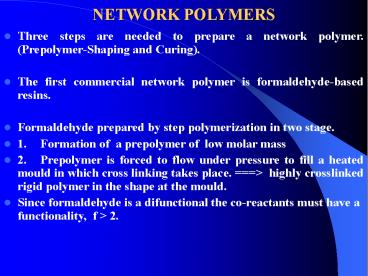NETWORK POLYMERS - PowerPoint PPT Presentation
Title:
NETWORK POLYMERS
Description:
NETWORK POLYMERS Three steps are needed to prepare a network polymer. (Prepolymer-Shaping and Curing). The first commercial network polymer is formaldehyde-based resins. – PowerPoint PPT presentation
Number of Views:104
Avg rating:3.0/5.0
Title: NETWORK POLYMERS
1
NETWORK POLYMERS
- Three steps are needed to prepare a network
polymer. (Prepolymer-Shaping and Curing). - The first commercial network polymer is
formaldehyde-based resins. - Formaldehyde prepared by step polymerization in
two stage. - 1. Formation of a prepolymer of low molar mass
- 2. Prepolymer is forced to flow under pressure to
fill a heated mould in which cross linking takes
place. gt highly crosslinked rigid polymer in
the shape at the mould. - Since formaldehyde is a difunctional the
co-reactants must have a functionality, f gt 2.
2
- The most commonly employed are
3
PHENOL FORMALDEHYDE RESIN
- The OH of the phenol activates the O P position
of the ring.
Further reaction leads to the formation of
methylene bridge and dimethylene ether link
4
- OH
OH OH -
CH2 CH2 -
-
Novolak CH2 - OH
- H2C-HO
- OH
OH -
CH2OH HOH2C CH2OH -
- CH2OH
CH2OH - Resoles
5
- There are two types of phenol-formaldehyde resin.
- 1. Resoles prepared with excess formaldehyde with
base catalysis. The product contain many
unreacted methylol groups which upon heating
react to produce the net work structure. - 2. Novolaks prepared with excess phenol and acid
catalysis which promotes condensation reaction of
the methylol groups. The prepolymers contain no
methylol groups and are unable to crosslink.
- Curing achieved by the addition of hardeners
(curing agent).
6
UREA AND MELAMINE FORMALDEHYDE RESIN
- The reaction of urea and melamine formaldehyde
resin involves the formation and condensation
reaction of N-methylol groups.
- Same reaction is used to prepare the
melamine-formaldehyde.
7
EPOXY RESINS
- They are formed from prepolymer containing the
epoxide end group
8
- These resin are either viscous liquid or solid
depending on n. - Curing usually achieve by using of a
multifunctional amines.
9
- Epoxy resin are characterized as low shrinkage on
curing, and used as adhesives, electrical
insulators, surface coatings and matrix materials
for fiber reinforced composites.
10
POLYURETHANE NETWORKS
- Uses
- Elastomers, flexible foams and rigid foams)
- Preparation
- By the reaction of diisocyanates with branched
polyester or Polyethers which have hydroxyl end
groups.
- Cross linking density and molar mass control the
flexibility of the network formed.
11
Thank You
- See You Next Lecture

